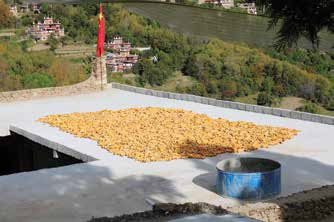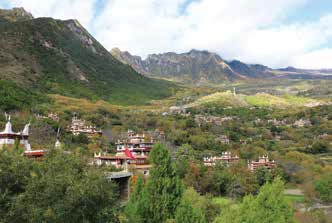|
Read 13362020 times
Connect me to:
|
Tibetan VillagesChinese Ethnic Minorities and Their Foods
Summer Volume: 2019 Issue: 26(2) pages: 21 to 22
Near Donba and Jianju, near Tibet too, we learn
and taste foods from Tibet. Before that we stop
to visit the Song An Temple. It looks as though
covered in gold, but the roof is copper and shining in the
sunlight. Yellow Buddhists live and work here. When we
arrive they are in the fields or running errands, only one
monk is here and near the entrance. He meets us in front
and tells us twenty-four local tribes live nearby, most are
Buddhists, and they worship here. They are from the
‘Value of Beauty’ area. After we look around, we go to
the fish restaurant called Qiong Lai. It is on our way to
but quite far from Chengdu. Our driver says we should
eat there and try their Pig’s Feet Soup local-style.
We love its many noodles, mine made with sweet
potatoes as requested, my husband’s and all others are
made with wheat flour. Every one’s is fantastic, some
are stir-fried with sliced wild mushrooms and sliver of
silver carp, red, yellow, and green piquant peppers,
garlic slivers, and red carrot strips. There is also pork,
wild mushrooms, beef, pickles, and greens that look like
lettuce but it is celtuce cut in thin strips. Later, we stop to have Shuangliu, a pig intestine soup
similar to that had at the earlier place, but it is really
not a soup, just more like a stew. Our driver makes sure
we miss no special food on the way including some at a
side-of-the-road dumpy places we would not otherwise
know to try. The dishes there have oodles of noodles,
chives, small pieces of cilantro and scallion, and a
gorgeous view looking at the Four Girls Mountain. It is
late October and the far-off mountain peaks are covered
with snow he says is fresh from a week ago. We did see them when we came out of a five mile tunnel,
the longest seen so far in China. He says it is not the
longest in China or elsewhere, and asks us if we are
aware it is on the way to the Bailang Mountain and the
Panda Research Station. Then, we stop to purchase apples, figs, walnuts and
other nuts, and some very dry pork as hard as nails. It
is a local delicacy, spicy and very good though biting
in is no easy task, it tastes like the local cement-brick
houses we see. All are topped with red, black, and white
designs, and corn drying on their flat roofs. The driver
says the designs are Tibetan and that is how he knows
who lives in them, the tall bunkers with slits on their
sides seen before are Suopo Bunkers once used to fire
at less friendly tribes causing havoc here. They are not
used now. Mostly focused on food, that night we stop for dinner
getting some street food including pancakes filled with
yak butter under coarse sugar and delicious yogurt. We
have these and other Tibetan foods with milk tea loaded
with more coarse sugar. The pancakes are filled with
chopped potatoes, some with pickled pork called jia
rong. Every one is fried in hot oil and with some of the
corn we saw drying. He says that some of the corn is
mixed with pork cracklings, sweet potato pieces, and
highland barley. The next day we meet Professor Zhao’s niece for lunch.
Going in her Honda we are off to ‘Shujouxia.’ She calls
it her and many others Number one special hot pot
restaurant. She also says it is the first of many with that
name. There, she orders a special hotpot sauce with two
and not nine sections telling us the other one might be
too piquant for us. While there, she cooks most of my
meats and organ meats. They are among the dozens she
orders. As to the sauce, she is probably right as this one
burns all the way down. This dipping sauce is special, made before our eyes first
using a sealed can of special sesame oil, about half cup
of it. This beauty of a place, open since the early 2000s,
uses one can as the base of the other ingredients at every
table. Special it is, and they gave us one to take home;
still have not opened it. In truth the sauce is superb.
Some of us do spill and need an apron replacement
more than once. No one there seems to mind; we are
glad they are not caring about the laundry we make for
them during the more than two hours we indulge as did
our clothes. After lunch, we get to see their kitchens, cleanest places
of any ever. Here, their hot pot is unique, so was the
citrus beverage we had before; it was to clear our palates,
and was made with yogurt, soy milk, or both. It did coat
all flavors from earlier meals, and prepared us for this
huge one. No dinner this night, we are too full. This restaurant serves beautiful presentations. For
instance the beef stomach, string beans split the long
way, konbu leaves, lotus root circles, sweet potato
slices, enoki mushrooms, rabbit, goose, fresh or roasted,
goose intestine strips, and some thirty other meat and
vegetable offerings each is a picture, even the coagulated
pork blood, lamb pieces, bacon, beef, and on and on.
After we polish off every meat served and cooked for
me, each of us is are handed a plate with five different
fruits, most cut in triangles, each juicy and very ripe.
Loved every one of them! Every food comes plated like a picture. One is better
looking than the one before it. There are outstanding,
a yellow tofu made with egg yolk, and (See the pictures
below on this page of the corn drying on the roofs and
the designs painted on their homes.) On TV we get to see their ‘‘Big Story’ about a long
bridge and tunnel complex traversing four man-made
islands and four tunnels built in thirty-three sections,
not a robot used to do so. Modeled on many seen by
its engineer Lin Ming and chief designer Meng Li and
their crews. We were told that this marvel can be seen
on CGTV’s “America CGTV Big Story’. This magnificent
bridge and tunnel complex was made to connect Hong
Kong to China with stops along the way. We had never
heard of it but now know of its existence.
The next day we stop on Restaurant Street in Chengdu
and had delicious Diced Rabbit with Orange Peel, also stir-fried
Sea Cucumber with Piquant Peppers, Mapo Doufu,
Zhoa Dumplings in an egg sauce, and many other dishes,
one better than the next. This place is across the street
from a ferry we take in the morning to see a huge statue
of a sitting Buddha there. The next day we also eat at the Deng Quiang Restaurant in
Leshan after the short boat ride to see that sitting Buddha.
We all adored all we ate including more corn and doufu
in the Jin Hotel, and Xiba Tofu, the softest, silkiest, and
most succulent tofu ever with barley tea grown by local
Yi people called shu jiu xiang. Visit here if you have the
chance, they surely know how to make great Chinese food.  
|



